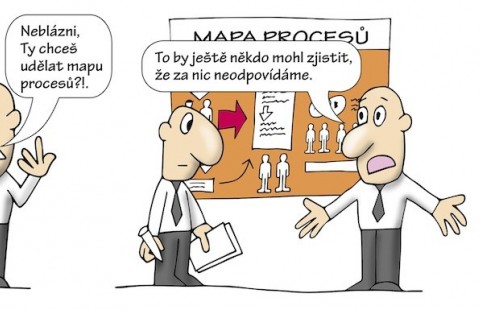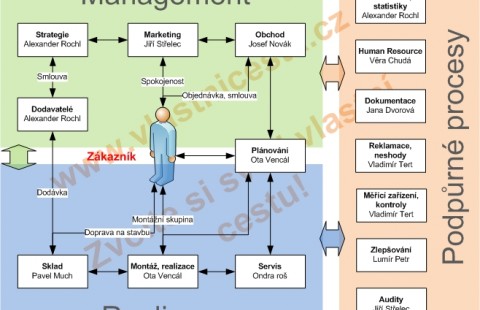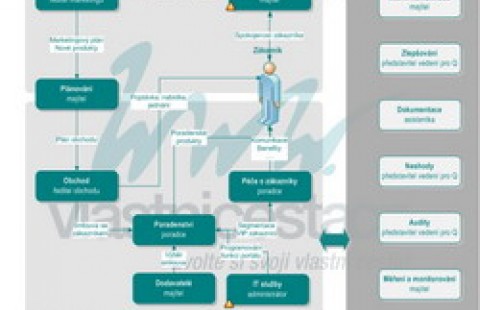Not a crown wasted. Not an hour of a man´s capacity lost. Yes, such is the principle of efficiency of today´s management. Yet we all are well aware that it does not always come out as intended, and the resulting losses are then accepted. No human works as efficiently as a machine and needs to be in search of the right way to introduce a new change. Finding out how to achieve exactly that is what our series called The Management of Change deals with.
Neither technology nor logic is necessarily bound to engage the workers
A new change has come. Managers and team-leaders mostly have no trouble describing it correctly. They define the ramifications or, possibly, make calculations to see whether implementing the change will bring a higher efficiency (in the processes, in the project, in the development …). They are familiar with their working environment and have had the experience in what will work technically and how, and what will not, so they will find it easy to prepare a logically correct procedure to introduce that change; see the table, the first column.
| Technology of change | Junction | Psychology of change |
|---|---|---|
|
+ |
|
|
Let us join the technology with the psychology. Let us create a procedure that will make the team members engaged, naturally and individually, throughout the separate stages. |
||
They will describe the future condition in logical terms, set up all the changes in activities and processes, select the right kpi for the measurement of the change. They will integrate all the above into a single plan. As a matter of course, they will make a plan of all the crucial subsequent activities. Based on the nature of the particular activities, they will choose workers who possess the necessary skills and calculate or estimate the needed capacities. Once everything fits so logically into the scheme of things, it will only suffice to present the plan and get down to work. It is here that the implementation of the new change can really meet with a fierce opposition. Even though the workers understand the logic and the wonderful simplicity of that way, they might not get actively involved just because they are getting one extra assignment. Perhaps they might feel left out, not needed for their own ideas but, rather, to be just a part of somebody else´s plan. A good plan alone is not going to make the workers want to implement it.
Psychology starts workers up
Not everyone wants to join in right away, not everybody can see the potential benefits for themselves and the team, regardless of the fact that it should be his or her obligation as part of the scope of their employment. The higher efficiency might work to have them laid off, or they may have to learn new things that they are not good at. Their mental, mostly invisible motivations might hold them back from getting involved, from being creative. Putting it frankly - “How many of us will go for new projects just because we know we can aways learn something new that we can make use of later in our lives?” 

The Real | Interim Manager for Your Changes

Manager work model

Time management - making use of time effectively

Jak správně tvořit mapu procesů

Modelling and setting the processes and procedures - ISO 9001

Training - preparation of the SWOT analysis and strategy

Company Management System of Quality Step by Step - ISO 9001

Process map acc ISO 9001 - business offer

IT staff communication
Apart from the logical plan, we need to prepare a "psychological" plan as well; see the table, the second column. Changes demand an active involvement of the workers´ potential. Make them believe that innovations represent their positive future. Every man´s future is, necessarily, different. It originates in themselves, their beliefs, views and experience. In order to achive this, the manager needs to know every worker and take them as a unique individuality. The manager should be familiar with their successes, failures, the style in which they communicate, but also the incentives that they react positively to and that make them deploy their potential.
In addition to all the above, everybody walks through various stages of life experiencing stressful situations. At times they have to deal with unexplicable conduct of their colleagues (relationships). Another time they may already be fighting the burnout syndrome. How to distinguish between a mere shor-term high-intensity stress and a burnout, or laziness in a worker who has mastered all the nuances of the art of communication? It is definitely possible. All it takes is to involve a professional psychologist.
The involvement of professionals of diverse specializations can expedite changes or bring about synergic effects. Imagine a technically minded manager. If they really want to think out the technical side of the matter very well, they have to think in technical terms. Just as they are thinking in technical terms, they might easily miss some of the issues related to relationships. The same applies to a psychologist. If, however, two different types of managers meet (a technically minded one and a psychologically minded one) and are able to cooperate, they will match each other well, each to oversee his or her side of the business. After all, we cannot be experts in all the relevant specializations, for the progress keeps making great advances. Combining their individual qualities will make them a brilliant tandem that is going to be much appreciated not only by the top bosses - due to proven results, but also by people through their personal development. Ultimately, there will be a shining future perspective for everyone. Our OwnWay advisors have already created such tandems and applied them successfully with their clients.
Paradoxically, a change motivates
I do not mean only the change we need to implement, but also the change in the style of leadership. A changed method in searching for the solution. Most managers apply those methods that have already proven their worth in practical problem-solving. When a method worked with one problem it should work with another too, correct? However, there are always more variants of a method, for instance:
- You will outline a subject, present examples and then have the team look for their own solution.
- You will give the team an assignment without limiting conditions and have them find 3 solutions, a minimum. Only then you are going to show them other possibilities. Subsequently, you will show them other applications or experience from elsewhere. Then, let them decide what they are going to include in the solution and what not.
- You will select an appropriate method, the Ishikawa diagram, for instance, and give them a partial assignment with limitations that fit into the context of the problem being resolved. Then contextualize the results accordingly.
- Prepare the whole concept of the future condition beforehand. Present the benefits or look for them together. Wait until everybody has seen a role for themselves somewhere in the concept. Only then, you give individuals or teams specific assignments.
These are just some of the possibilities how to proceed, how to look for the solution with the team. Trust me, if you tend to choose invariably method no.2, for instance, you will be getting a declining number or ideas or permanently similar solutions. There will be no revolutionary solution. Try and change your procedure and you may win plaudits from the team. A change in the procedure, something new that people are not accustomed to, motivates by itself. Naturally, only if we have had the right corporate culture of the team/company. The atmosphere of fear serves to discourage these procedures.
More prep time means a better final solution
The future lies with solutions that are innovative (creative). They have a new potential on the market. Workers believe in that potential, actively seeking to get engaged because they want to. Every good manager knows it is impossible to have an employee engage their potential simply by ordering it. There is more than just the solution logic. It is psychology and communication working together. Eventually, you will find that the introduction of a change where you considered the human factor, thus allowing more time for preparation (how to communicate the change, how to engage the workers, ...),is, in the final analysis, more effective. Your team will work out and finalize what has not even crossed your mind.



